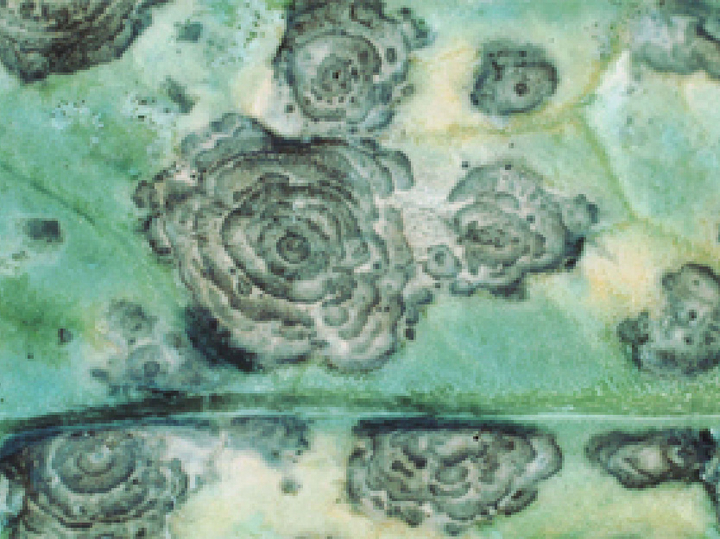Turnip mosaic virus
Turnip mosaic virus
Damage symptoms

Since there are several virus strains of cabbage black ring virus, the disease symptoms also vary among the cabbage species, sometimes even among the varieties.
On white cabbage and savoy cabbage, small patches of lightening are initially visible on the leaves, bordered by fine veins. Later, chlorotic to necrotic rings develop. These eventually turn black and are somewhat sunken into the leaf tissue. Infestation can extend far into the interior of a cabbage head. These ring-shaped spots also occur on petioles and stalks. A blurred mosaic blotch on leaves may also occur. More rarely, leaf drop also occurs.
On red cabbage , the spots are initially greenish in color. As they develop, they become chlorotic and sometimes form concentrically arranged rings. In addition, small black spots may still appear on cabbage, as they are also caused by cauliflower mosaic virus. However, the spots caused by black ring spot virus are larger and have a distinct necrotic center.
Cauliflower and sprouting cabbage show round chlorotic spots with a partially green center. Necrosis is also very common along leaf veins. Diffuse leaf spotting occurs on cauliflower and cabbage. On cabbage, small necrotic spots or circles are additionally found on the older leaves.
When kohlrabi is infested, the leaf veins are lightened, and dark vein banding also occurs in some cases.
Extremely at risk from the virus is Chinese cabbage. If early infection occurs, growth is inhibited and leaves are severely curled. The leaves show a whitish-light-dark green leaf spot. As a result, head formation is absent.
Propagation and transmission
The virus is not transmissible by seed, but it is transmissible mechanically. Many aphid species are possible carriers of this non-persistent virus. The most important vectors are the mealy cabbage aphid(Brevicoryne brassicae) and the green peach aphid(Myzus persicae). The virus is picked up by aphids in less than a minute and can be transmitted by an aphid within a minute.
Prevention and control
- When growing cabbage crops, maintain a distance of at least 2 km from seed-bearing crops and allotments.
- Carefully control cruciferous weeds that may serve as winter hosts. The host plant range is larger than for cauliflower mosaic virus, and includes a great many ornamental plants.
- Control the vectors of the virus in time (see list of plant protection products approved in Austria).
- Remove crop residues and any outgrowths before new plantings.
Last updated: 17.01.2022
automatically translated